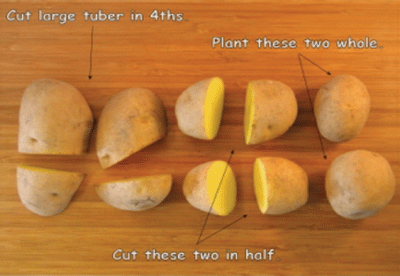A Guide to Growing Potatoes In Your Home Garden
 People often wonder if it is possible to grow vegetables in your own home garden on this side of the world and the answer to that is, YES. There are a variety of different plants, including vegetable and fruits that can be grown in this region without the use of Greenhouse technology or requiring special attention.
People often wonder if it is possible to grow vegetables in your own home garden on this side of the world and the answer to that is, YES. There are a variety of different plants, including vegetable and fruits that can be grown in this region without the use of Greenhouse technology or requiring special attention.
Growing potatoes is fun and not that hard! Home gardeners can grow unique varieties that are not sold in local supermarkets. Potatoes come in all different shapes, sizes and colours. Did you know that there are purple, red and yellow potatoes? Potatoes make a great garden project for your children or grandchildren
Seed Preparation
Depending on the source and the quantity you buy you will receive either small tubers or large tubers. Small tubers (2.5 to 5 cm in diameter) can be planted whole. Cut large tubers into block-shaped, 50 to 70 grams seed pieces (about the size of an egg). The seed pieces should be firm, with at least one “eye” (Centre) per section and a maximum sprout length of 0.5 to 1.5 cm ensure optimum germination. Seed tubers can be cut and planted on the same day, however allowing the cut surface to heal over for 4-7 days may reduce the risk of seed pieces rotting in the soil.
Figure 1: Seed Preparation
Soil Preparation and Fertility Potatoes grow on a wide range of soils, but are best suited to a sandy soil or a soil that is well drained. Very sandy soils may require extra watering to maintain adequate soil moisture. Fine textured soils that are high in silts and clay may not be well drained, and they tend to produce poorly shaped potatoes. If possible, a soil test can be performed before planting.
You may contact us for details. The best soil pH for potatoes is between 5.5 and 6.0. A pH above 6.0 may increase the incidence of common scab (a disease) on tubers. If a soil test is not available, follow these recommended guidelines:
Mix the soil of existing plot of land with Peatmoss
Rosafert into the seedbed about 1 KG pounds per 15 Meters of row of 12-12-12 (N-P-K) analysis fertilizer
Beside the row, apply 150 grams per 15 meters of row of 46-0-0 Urea fertilizer one week after plant emergence and again between 4 and 6 weeks after emergence.
All Chemicals mentioned above are available at AQUA TECH store or local gardening stores
Water Requirements
Potatoes are very sensitive to soil moisture and do best with a consistent soil moisture level.
Even soil moisture levels throughout the root zone should be maintained, though over wet and saturated conditions should be avoided. In general, 1 liter of water per week from rainfall or irrigation is adequate.
Planting
This table shows the time in the year that will give you the optimum results

Growing season Planting: mid-October to mid-December
Harvest period: Early February to mid- Apr
 Figure 2: How potatoes are Planted
Figure 2: How potatoes are Planted
Time of maturity varies for each variety. Indicators of tuber maturity include complete vine death, “skin set” (tuber skin does not peel from the flesh when pressure is applied) and desired tuber size.
Mature tubers store better and are less likely to bruise or decay than immature tubers. New or small tubers can be harvested early without destroying the entire plant by careful digging and removing some of the tubers. The remaining tubers should be left to grow and reach full maturity Use a spade or fork to loosen the soil and gently lift the tubers out of the soil. To prevent greening and sunburn damage, do not allow tubers to be exposed to light after harvesting.
Happy Gardening!
 Tariq ElAsad
Tariq ElAsad
‘Watering Cacti’
Landscape Division Manager
AQUA TECH Landscape and Civil Services

